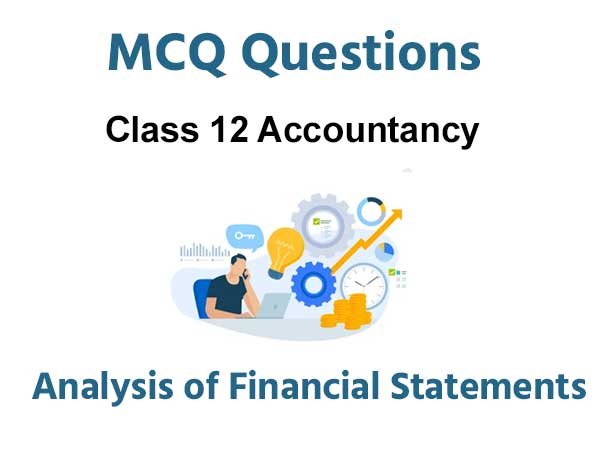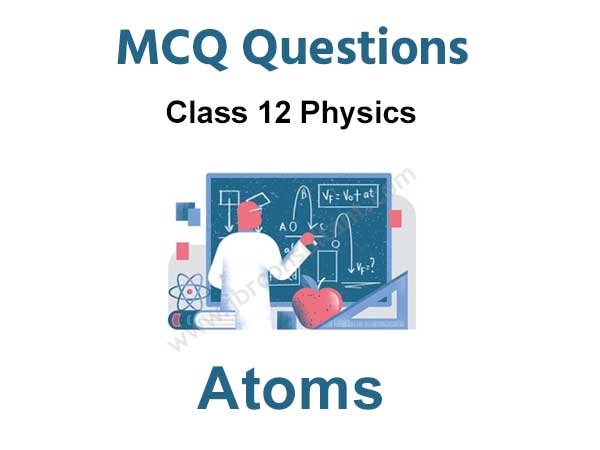Class 12 Analysis of Financial Statements MCQ is one of the best strategies to prepare for the CBSE Class 12 Board exam. If you want to complete a grasp concept or work on one’s score, there is no method except constant practice. Students can improve their speed and accuracy by doing more Financial Statement Analysis Class 12 MCQ Class 12 which will help them all through their board test.
Class 12 Analysis of Financial Statements MCQ Questions with Answers
Class 12 Accountancy MCQ with answers are given here to chapter the Analysis of Financial Statements. These MCQs are based on the latest CBSE board syllabus and relate to the latest Class 12 Accountancy syllabus. By Solving these Class 12 MCQs, you will be able to analyze all of the concepts quickly in the chapter and get ready for the Class 12 Annual exam.
Learn Analysis of Financial statements Class 12 MCQ with answers pdf free download according to the latest CBSE and NCERT syllabus. Students should prepare for the examination by solving CBSE Class 12 Analysis of Financial Statements MCQ with answers given below.
Question 1. When bad position of the business is tried to be depicted as good, it is known as …………….
(A) Personal Bias
(B) Price Level Changes
(C) Window Dressing
(D) All of the Above
Answer
Window Dressing
Question 2: Importance of Comparative Statement is
a) All of the options
b) Make the data simple and more understandable
c) Indicate the trend with respect to the previous year
d) compare the firm performance with the performance of other firm in the same business
Answer
All of the options
Question 3. Main limitation of analysis of financial statements is
(A) Affected by window dressing
(B) Difficulty in forecasting
(C) Do not reflect changes in price level
(D) All of the Above
Answer
All of the Above
Question 4: The Real object of Analysis of Financial Statement is
a) To measure the financial strength of the business
b) To assess the total expenses of the firm
c) To know about historical cost concept
d) To assess the total liabilities of the firm
Answer
To measure the financial strength of the business
Question 5. The financial statements of a business enterprise include :
(a) Balance sheet
(b) Statement of Profit and loss account
(c) Cash flow statement
(d) All the above
Answer
(d) All of the above
Question 6. Which of the following is a type of Financial Analysis on the basis of material used ?
(a) Internal Analysis
(b) External Analysis
(c) Internal Audit
(d) Both (a) and (b)
Answer
Both (a) and (b)
Question 7. While preparing Common-size Balance Sheet, each item of Balance Sheet is expressed as % of
(a) Current Assets.
(b) Non-current Assets.
(c) Non-current Liabilities.
(d) Total Assets.
Answer
Total Assets.
Question 8. Main objective of Common Size statement is :
(A) To present the changes in various items
(B) To provide for a common base for comparison
(C) To establish relationship between various items
(D) All of the Above
Answer
All of the Above
Question 9: In which analysis Financial Statement for a single year analysed
a) Vertical Analysis
b) Dynamic Analyses
c) Vertical Analysis and Dynamic Analyses
d) None of the options
Answer
Vertical Analysis
Question 10: To whom Importance of Financial Analysis is
a) All of the options
b) For Management
c) For Investors
d) For Creditors
Answer
All of the options
Question 11. What is shown by Balance Sheet ?
(a) Accuracy of books of accounts
(b) Profit or loss of a specific period
(c) Financial position on a specific date
(d) None of the above
Answer
C
Question 12: Rent received, Profit on sale of fixed assets, Compensation for acquisition of land are example of
a) Non-operating Incomes
b) Operating Incomes
c) Operating expenses
d) None of the options
Answer
A
Question 13. The most commonly used tools for financial analysis are :
(a) Horizontal analysis
(b) Vertical analysis
(c) Ratio analysis
(d) All the above
Answer
(d) All the above
Question 14: each item is expressed as a percentage of some common base in
a) Common size statement
b) Fund Flow Statement
c) Cash Flow Statement
d) Cash Flow Statement
Answer
Common size statement
Question 15. In the Statement of Profit & Loss of a Common Size Statement:
(A) Figure of net revenue from operations is assumed to be equal to 100
(B) Figure of gross profit is assumed to be equal to 100
(C) Figure of net profit is assumed to be equal to 100
(D) Figure of assets is assumed to be equal to 100
Answer: A
Answer
A
Question 16: Common size analysis is also known as ______ Analysis
a) Vertical
b) Vertical
c) Vertical
d) None of the options
Answer
Vertical
Question 17: Importance of Comparative Statement is
a) All of the options
b) Make the data simple and more understandable
c) Indicate the trend with respect to the previous year
d) compare the firm performance with the performance of other firm in the same business
Answer
All of the options
Whoever needs to take the CBSE Class 12 Board Exam should look at this MCQ. To the Students who will show up in CBSE Class 12 Accountancy Board Exams, It is suggested to practice more and more questions. Aside from the sample paper you more likely had solved. These Financial Statement Analysis Class 12 MCQ PDFs are ready by the subject specialists themselves.
Question 18. Comparative statements are also known as :
(a) Dynamic analysis
(b) Horizontal analysis
(c) Vertical analysis
(d) External analysis
Answer
(b) Horizontal analysis
Question 19. Which objective is not fulfilled by comparative financial statement:
(A) Indicate the extent of change in assets and liabilities
(B) Indicate the extent of change in items of Statement of Pofit & Loss
(C) Show effect of operative activities on assets and liabilities
(D) Show the direction of change in assets and liabilities
Answer
Indicate the extent of change in items of Statement of Pofit & Loss
Question 20. When bad position of the business is tried to be depicted as good, it is known as …………….
(A) Personal Bias
(B) Price Level Changes
(C) Window Dressing
(D) All of the Above
Answer
C
Question 21. The analysis of financial statement by a shareholder is an example of:
(a) External Analysis
(b) Internal Analysis
(c) Vertical Analysis
(d) Horizontal Analysis
Answer
External Analysis
Question 22: Ratio analysis establishes relationship between
a) Two financial statements
b) Two Share Holder
c) Two Debentures Holder
d) None of the above
Answer
Two financial statements
Question 23: Financial year always begins on
a) 1st April-31st March
b) 1st January-31st December
c) 1st August -31st July
d) None of the options
Answer
1st April-31st March
Question 24. The most commonly used tools for financial analysis are :
(A) Comparative Statements
(B) Common Size Statements
(C) Accounting Ratios
(D) All of the above
Answer
D
Question 25: The analysis of financial statement by a shareholder is an example of:
(a) External Analysis
(b) Internal Analysis
(c) Vertical Analysis
(d) Horizontal Analysis
Answer
A
Question 26: Bring out the importance of Financial Analysis
a) All of the options
b) Helps in evaluating the profit earning capacity and financial feasibility of a business
c) Helps in evaluating the profit earning capacity and financial feasibility of a business
d) Helps in evaluating the relative financial status of a firm comparison to other competitive firms
Answer
All of the options
Question 27. Financial analysis become useless because it:
(A) Measures the profitability
(B) Measures the Solvency
(C) Lacks Qualitative Analysis
(D) Makes a comparative study
Answer
C
Question 28: each item is expressed as a percentage of some common base in
a) Common size statement
b) Fund Flow Statement
c) Cash Flow Statement
d) Cash Flow Statement
Answer
A
Question 29. In a common size Balance Sheet, total liabilities are assumed to be equal to
(A) 1
(B) 10
(C) 100
(D) 1,000
Answer
C
Question 30: Interpretation of Financial Statements includes:
(a) Criticisms and Analysis
(b) Comparison and Trend Study
(c) Drawing Conclusion
(d) All the above
Answer
D
Question 31: Common size statements can be classified into which broad categories
a) Common size statements can be classified into two broad categories and Common Size Balance Sheet
b) Common size statements can be classified into two broad categories
c) Common Size Balance Sheet
d) None of the options
Answer
A
Question 32. Analysis of Financial Statements is significant:
(A) For Creditors
(B) For Managers
(C) For Employees
(D) For all of the above
Answer
D
Question 33. Creditors or Suppliers are interested to know the
(a) Profitability of the firm in relation to turnover.
(b) Profitability of the firm in relation to investments.
(c) Short-term solvency/liquidity of the concern.
(d) Effective utilisation of its (firm’s) resources.
Answer
C

You can easily get good marks If you study with the help of Analysis of Financial statements Class 12 MCQ. We trust that information provided is useful for you. NCERT Class 12 Analysis of Financial Statements MCQ PDF Free Download would without a doubt create positive results.
We hope the information shared above in regards to Financial Statement Analysis Class 12 MCQ with Answers has been helpful to you. if you have any questions regarding CBSE Analysis of Financial statements Class 12 MCQ ,Write a comment below and we will get back to you as soon as possible.
Frequently Asked Question (FAQs)
How many MCQ questions are there in Class 12 chapter 4 Accountancy?
In Class 12 chapter 4 Accountancy, we have provided 33 Important MCQ Questions, But in the future, we will add more MCQs so that you can get good marks in the Class 12 exam.
Can we score good marks in Class 12 Accountancy with the help of Analysis of Financial Statements MCQ Questions?
Yes, MCQ Question is one of the best strategies to make your preparation better for the CBSE Board Exam. It also helps to know the student’s basic understanding of each chapter. So, You can score good marks in the Class 12 Accountancy exam.


